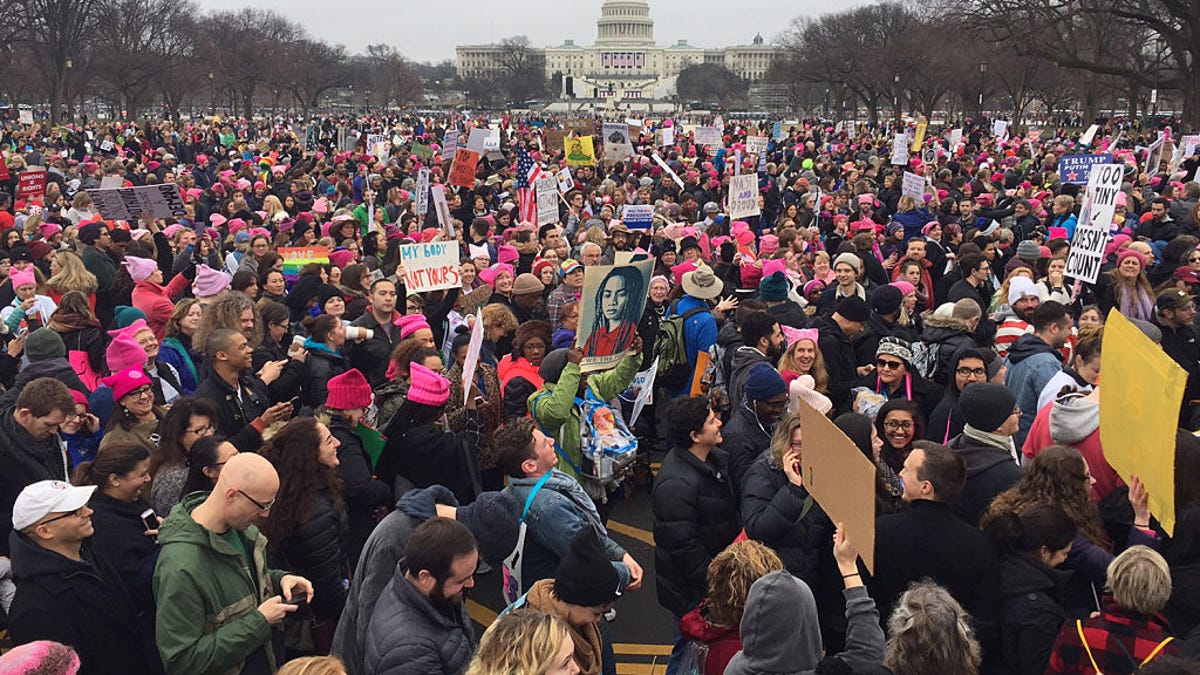How Facebook, Twitter jumpstarted the Women's March
The heads of the Women's March on Washington speak about the impact of social media in staging protests.

Demonstrators protest on the National Mall for the Women's March on January 21, 2017.
Carmen Perez can attest to the changes that have taken place in political protesting.
She's the executive director of a nonprofit founded by Harry Belafonte, who was a part of the 1963 March on Washington. In Belafonte's office, Perez saw an old telegram from Martin Luther King Jr. about the march. She just had to ask how long it took to correspond by telegram. It took weeks, he told her.
By contrast, Perez says the Women's March on Washington, which she co-chairs, had social media on its side. Organizers could talk via an instantaneous direct message.
The idea for the protest started popping up on Facebook on election night. Teresa Shook of Hawaii invited 40 friends to her protest page and woke up to 10,000 followers in the morning. Bob Bland, a New York-based fashion designer, also made a page, as did many others. Soon after, all the protests were consolidated.
"Everything just went viral," Perez said in an interview before she appeared at on a panel with march organizers at Vanity Fair's Founders Fair in Brooklyn, New York. Perez and Bland are both co-chairs of the protest, which took place in January and prompted about a half million people to turn up in Washington the day after the inauguration. It also inspired sister marches around the world in Los Angeles, New York, Sydney, Berlin, Buenos Aires and other cities.
Organizers are exploiting the internet's prodigious powers to rally protesters. It's been used to bring people together around an idea, like women in tech. In September 2015, the hashtag #ILookLikeanEngineer inspired a storm of tweets challenging the stereotype that engineers were all hoodie-clad white guys. It can be used to channel anger toward corporations. Just last week, United Airlines felt the wrath of the world after video of a doctor being physically removed from a plane went viral.
Perez said social media streamlined the organization of the women's march, making it easier for people to join the movement. About 45,000 protesters with disabilities participated in the Washington march because they used social media ahead of time to make sure the demonstration was accessible.
Facebook gave the co-chairs -- Perez, Bland, Tamika D. Mallory and Linda Sarsour -- a way to get a feel for who was interested in attending, as well as what information they needed, how the logistics were changing and what issues were relevant. In addition to interested participants, they were able to create groups to work with local and state organizers, and partner organizations.
Early on, conversation on social media highlighted the folks organizing the march were all white women, Bland said. That prompted Bland, a white woman, to look to social media, where she connected with co-chairs Sarsour, Mallory and Perez.
The ability to send a direct message or even post a meme proved vital.
Social media "allowed us to create entry points for people who don't necessarily receive mail, or watch the news," Perez said.
In the months after the march, Perez said the organizers are still leaning on social media. An Instagram post can get between 20,000 and 50,000 likes, an important way to keep momentum going through campaigns such as 10 Actions for the first 100 Days. (The campaign prompts participants to take action on an issue every 10 days by doing things like writing to your senator.)
Each social media platform has a purpose, Perez says.
Instagram is inspirational but less interactive. Think posts with messages like "Resist. Rest. Repeat." Twitter is a good spot to share what partner organizations are up to, and Facebook serves as peak interaction. It's impossible to talk to everyone, everyone, all the time-- but Facebook helps, Perez says.
Still, for all the ways in which social media has changed the way a protest, Perez thinks of it as a way to "complement tactics from the past." That means organizers need to make phone calls and talk with people one on one.
But don't expect them to send you a telegram.
It's Complicated: This is dating in the age of apps. Having fun yet? These stories get to the heart of the matter.
Tech Enabled: CNET chronicles tech's role in providing new kinds of accessibility.

